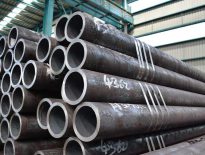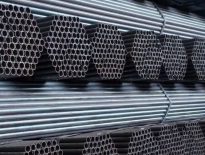Solitaire Overseas specializes in heat exchanger tubes, which are used to cool, heat, or reheat fluids, gas, and air. We provide a wide range of thin-wall heat exchanger tubing to meet the specific needs of companies producing shell and tube heat exchangers.
A heat exchanger is a heat transfer device between a solid body and a fluid, or from two or more fluids. Such materials are segregated by a wall such that they are not combined, though they may be in direct contact. Heat exchangers play an important role in the functioning of multiple systems and procedures. The heat exchanger is for example found in the hot water boiler, the freezer. Energy is transmitted to the boiler in the former situations and energy is transferred away in the latter, so that the freezer stays cool.
There are several different types of heat exchangers. The heat exchangers with double pipes are very basic in structure and are used in the industry. The repairs and design are cheaper. They are, on the contrary, low in efficiency and occupy a large space. Modern factories then use more effective heat exchangers called the shell and tube or plate.
There are several tubes in the heat exchanger. They are available in a wide variety of materials, including Stainless Steel Heat Exchanger Tubes, duplex stainless steel, nickel alloys, zirconium, and titanium, suitable for all types of heat exchangers such as heaters, evaporators, condensers, seawater coolers, and re-heaters.
The heat exchanger tubes are finned, plain, internal or external. Normal heat exchangers use plain tubes, while the finned tubes provide a high heat transfer surface. Another type of tube is the duplex tube, which is mounted inside the tube by drawing the tube out into the inner tube.
The tubes diameter varies from 6 mm to 40 mm. The thickness depends on the construction materials and their diameters. The length of the tube varies from 0.5 to 6 m. They lay either on a square or on an equilateral triangular pitch.
If the heat exchanger tube breaks, it can be replaced by expanding and rotating the tool to the ends of the tube in the tube sheet holes.
Types of Heat Exchanger Tubes & Characteristics
The type of heat exchanger tube is chosen based on the heat transfer rate and required heat load. The size and temperature demands determine the tube size. Tubes can be made in U-bent shapes or straight lengths, depending on needs. Interestingly, the basic design of heat exchangers stays consistent, regardless of size or complexity.
Heat exchangers are categorized by their design features, which influence their efficiency. These characteristics help determine the right application and include factors like heat transfer capability and material durability.
Classification Based on Flow Configuration
- Parallel Flow: Fluids move in the same direction.
- Counter Flow: Fluids move in opposite directions, making it more efficient than parallel flow.
- Cross Flow: Fluids move perpendicular to each other.
- Hybrid Flow: Allows multiple flow passes within the exchanger.
The flow rate is crucial as higher flow rates increase heat transfer but also raise velocity, reducing pressure, and making energy removal more challenging.
Classification Based on Heat Transfer Mechanism
- Single-phase Convection: Fluids remain in the same state throughout.
- Two-phase Convection: Fluids change state (e.g., from liquid to gas) during the process.
Types include:
- Single-phase convection on both sides
- Single-phase on one side & two-phase on the other
- Two-phase convection on both sides
- Combined convection and radiative heat transfer
Classification Based on Construction Method
- Capacitive Heat Exchangers: Warm and cool fluids alternate through the same channel. These can be static (components don’t move) or dynamic (components move during the process).
- Recuperative Heat Exchangers: Fluids flow through separate channels simultaneously.
- Direct contact: Fluids mix directly.
- Indirect contact: Fluids are separated by the tube walls
Common components include tubes, shells, plates, and fins. When choosing a heat exchanger, factors like the type of liquid in primary and secondary circuits, flow rates, and temperature must be considered.
Applications and Uses
Stainless Steel 304 Heat Exchanger Tubes are widely used in several industries due to their durability and resistance to corrosion. They serve crucial roles in chemical processing, hydrocarbon manufacturing, and oil refining. These tubes are essential for heating, reheating, and cooling gas, fluids, or air.
They are also used in power generation, including nuclear, solar, and thermal power plants. Other key industries that rely on these tubes include oil and gas, petrochemicals, chemical and fertilizer manufacturing, pulp and paper, atomic energy, defense, and aerospace.
Conclusion
Heat exchanger tubes are essential for efficient heat transfer across various industries, offering durability, versatility, and reliability in heating, cooling, and energy management applications.
Looking for high-quality heat exchanger tubes? Contact Solitaire Overseas today to find the perfect solution for your industrial needs. Our team of experts is ready to assist you with premium products tailored to your requirements. Get in touch now to discuss your project and request a quote!
FAQ
Q. What is the use of a heat exchanger tube?
Heat exchanger tubes are used to transfer heat between two fluids while keeping them separate. The tube walls facilitate heat exchange, and the overall efficiency depends on the specific configuration of the heat exchanger system.
Q. What are the different types of heat exchanger tubes?
The three main types of shell and tube heat exchanger tubes are fixed tube, U-tube, and floating head, each designed for specific thermal expansion and maintenance needs.
Q. Which pipe is used for heat exchangers?
Heat exchangers typically use pipes made from stainless steel, carbon steel, or copper alloys. Double pipe heat exchangers are simpler, while shell-and-tube designs offer greater flexibility.


